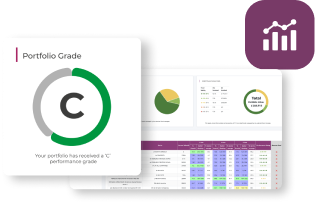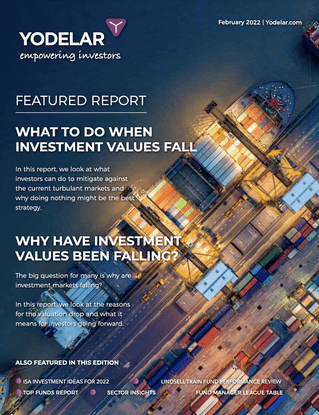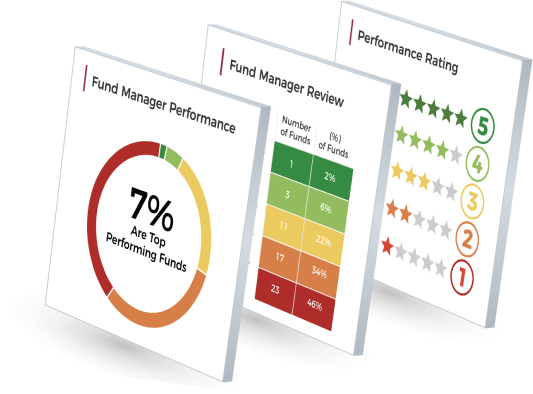-
Many investors continue to hold underperforming funds or outdated strategies due to inaction, leading to significant long-term opportunity costs.
-
Surface-level growth can mask deep inefficiencies, with hidden overlap and persistent fund lag often going unnoticed without professional analysis.
-
Delaying key portfolio adjustments such as rebalancing, fund switching, or aligning to life stage increases the risk of missed growth and unnecessary volatility.
-
A clear, data-driven review process helps investors identify weaknesses, reduce cost drag, and ensure their investments remain purposeful and efficient over time.
When it comes to investing, doing nothing can be more damaging than it appears. While markets may rise and portfolios may grow, that surface-level progress often masks deeper inefficiencies. Volatility is a normal part of investing and should be expected, but unmanaged inefficiencies can compound quietly over time and undermine long-term outcomes. Underperforming funds, excessive charges, and outdated strategies can quietly compound over time - steadily dragging down long-term returns.
For many investors, these issues persist not through conscious choice, but through a lack of clear oversight and decisive action. Portfolios are left on autopilot, shaped more by past decisions than current needs. And without detailed, benchmarked analysis, it’s easy to assume everything is on track - even when better-performing options exist.
In this article, we explore the compounding cost of investment inaction. We examine how poor fund selection, high fees, and delays in rebalancing or restructuring can erode performance over time. More importantly, we highlight why timely, data-driven portfolio management is essential to staying aligned with your goals and unlocking long-term efficiency.
Why Many Investors Overestimate Their Portfolio’s Quality
It’s common for investors to judge their portfolio based on whether it’s growing. If the overall value is going up, it feels like everything must be on track. But this surface-level view can be misleading. A portfolio can deliver positive returns and still underperform — sometimes significantly — compared to what similar portfolios or funds have achieved over the same period. Volatility is normal and should be expected, but underperformance caused by structural weaknesses should not be overlooked.
One of the most frequent surprises we see in portfolio reviews is just how much better some funds in the same category have performed. It’s not about chasing the highest returns, but about recognising when a fund is consistently falling short of its peers without a clear reason to expect a turnaround. These performance gaps can quietly build over time, and if left unaddressed, they can cost investors thousands in missed growth.
Another common blind spot is how diversified a portfolio really is. On paper, it may look well spread out across multiple funds. But dig deeper, and many of those funds often hold the same underlying companies - especially in popular markets like the US or technology sectors. This creates what we call hidden overlap, where the portfolio ends up relying too heavily on a small group of stocks, increasing risk without the investor realising.
Professional analysis helps cut through these assumptions. It looks at each fund’s performance relative to others in its category, checks for duplication across holdings, and assesses whether the portfolio as a whole is balanced for the investor’s goals and stage of life. This level of insight often reveals more than expected - and can highlight clear opportunities to improve efficiency, reduce risk, and unlock better long-term outcomes.
In short, what looks like a good portfolio at first glance may be falling short once you dig into the details. And without a review, those shortfalls can continue unnoticed.
Poor Fund Selection Carries a Long-Term Cost
Many investors hold funds that have persistently underperformed their sector average. In some cases, these funds have lagged behind for several years with no clear evidence of turnaround. The impact of holding such funds may not be immediately visible, but over time the opportunity cost is substantial.
A fund that underperforms its sector by just 2% per year may seem tolerable in isolation. But compounded over a decade, the gap can equate to tens of thousands of pounds in lost growth. What’s more, funds with poor outlooks - such as those overly concentrated in low-growth sectors or operating under inefficient mandates - are unlikely to reverse course without structural change.
Identifying underperformance is not simply about short-term dips. It involves reviewing fund returns consistently across 1, 3 and 5-year timeframes, and comparing them against sector averages. This approach reveals not only laggards, but also whether performance weakness is persistent or cyclical - and whether the fund’s strategy remains fit for purpose.
The Cost of Delaying Key Portfolio Adjustments
Even when inefficiencies are clear, many investors delay taking action. This may involve holding on to underperforming funds, avoiding rebalancing when asset weightings drift, or postponing broader restructuring to reflect changes in circumstances or financial goals.
Such inaction can quietly undermine the portfolio’s long-term effectiveness. For instance, remaining in a high-risk portfolio during retirement could expose an investor to levels of volatility that no longer suit their need for capital stability. On the other hand, younger investors who remain overly cautious may limit their ability to build long-term wealth through equity-based growth.
Effective portfolio management is not just about spotting issues—it’s about implementing the right changes at the right time. This includes:
- Reducing overexposure to concentrated sectors or regions
- Switching out of persistently poor-performing funds
- Re-aligning risk levels to match changing objectives
- Adjusting for tax-efficiency or income requirements as life stages evolve
Timely intervention is essential. Without it, portfolios often remain stuck in structures that are no longer fit for purpose, reducing efficiency and increasing risk just when the opposite is needed.
Staying Aligned With Changing Life Stages
As investors progress through life, their financial objectives, risk tolerance, and income requirements evolve - often significantly. A portfolio built in your 40s to maximise long-term growth may no longer be suitable in your 60s, when capital preservation and income become more important. Yet, many investors leave their portfolios untouched for years, failing to adapt them to shifting priorities.
This lack of realignment can result in portfolios that are either too aggressive or too conservative for the investor’s current circumstances. For those approaching or in retirement, excessive exposure to equities may introduce avoidable volatility just when stability is needed most. Conversely, investors in their accumulation years who remain overly cautious may miss out on valuable long-term growth opportunities, limiting their future financial security.
Keeping your investments aligned with your life stage involves more than simply dialling up or down the level of risk. It requires a careful reassessment of investment goals, time horizon, income needs, tax efficiency, and estate planning considerations. For example, transitioning to income-generating assets, reducing exposure to high-risk sectors, or increasing allocation to defensive funds may be appropriate in later years. For younger investors, it may be more suitable to review whether certain underperforming funds remain aligned with their long-term objectives - and where appropriate, consider switching to more suitable investments that offer stronger growth potential through improved fund selection, rather than increased risk.
Crucially, these adjustments should not be one-off reactions but part of an ongoing, structured review process. Proactive portfolio management - ideally within a framework that allows timely implementation - ensures that the investment strategy evolves in step with the investor’s changing life stage, keeping it purposeful and efficient throughout the financial journey.
Why Timely Action Depends on the Right Advice Model
In many cases, investor inertia is not simply a personal choice - it is a by-product of the advice structure itself. Some advisory models rely on infrequent reviews that focus on basic performance snapshots, without exploring deeper inefficiencies or evolving investor needs. Others are constrained by limited fund access or procedural barriers that make any meaningful change slow to implement.
In these reactive frameworks, identifying an issue is only part of the process. Whether it is an underperforming fund, an unbalanced asset mix, or an outdated strategy, the responsibility to initiate or approve changes often falls back on the investor. As a result, decisions that could improve portfolio outcomes are delayed or never actioned at all.
By contrast, discretionary investment management offers a more dynamic solution. Where permissions are in place, portfolio managers have the ability to:
- Replace consistently underperforming funds with more suitable alternatives
- Rebalance portfolios in line with market shifts or allocation drift
- Adjust asset positioning to capture emerging growth opportunities or mitigate risk
This approach enables timely, forward-looking action that keeps the portfolio aligned to the investor’s objectives - without requiring client sign-off at every stage. In uncertain or fast-moving markets, this responsiveness can make a meaningful difference to long-term outcomes.
Proactive Management: Turning Insight Into Action
Some of the most damaging investment outcomes do not result from bad decisions, but from the absence of decisions altogether. Inaction often goes unnoticed, yet it can steadily erode portfolio performance over time.
Whether it is the continued presence of underperforming funds, the compounding impact of high fees, or a failure to adapt to changing financial goals, these inefficiencies accumulate quietly. The longer they go unaddressed, the more they affect long-term outcomes.
Preventing this requires more than a periodic review. It demands clarity around what is working, what is not, and access to a structure that supports timely and appropriate changes. Proactive management ensures that portfolios remain efficient, relevant, and aligned to the investor's current needs.
Investors who stay engaged with their portfolio, or work with a manager who can act decisively on their behalf, are better equipped to respond to evolving markets and shifting objectives. This approach helps preserve long-term growth potential and avoids the hidden costs that often come from standing still.
Clarity Through Analysis: The First Step to Better Investment Decisions
Investing is not a one-off decision but an ongoing process of refinement and realignment. Even portfolios that once seemed well-structured can gradually drift off course - weighed down by underperforming funds, outdated strategies, or unintentional overexposure. While market growth can mask inefficiencies for a time, it’s the underlying quality and relevance of the holdings that ultimately determine long-term success.
Every investor will face periods of uncertainty, but it’s how efficiently these periods are navigated that matters. Delaying action can limit opportunities, increase risk, and reduce compounding potential - all without the investor necessarily realising it.
Proactive management starts with insight. For investors who have not reviewed their portfolio in some time, a clear and objective assessment can be the first step towards making more informed decisions. At Yodelar, our free portfolio review service can help identify where portfolios may be falling short, and where practical improvements can be made - whether through reducing cost, improving fund quality, or realigning strategy to current needs.
In many cases, the cost of inaction isn’t obvious until it’s too late to recover. But with the right support and structure, investors can stay on track - and make sure their portfolio remains as purposeful as their long-term goals.




















